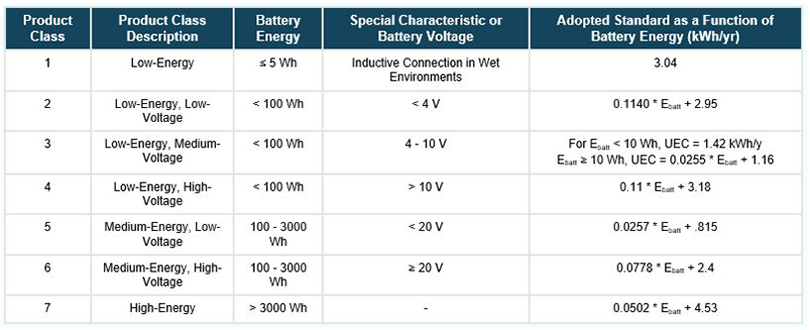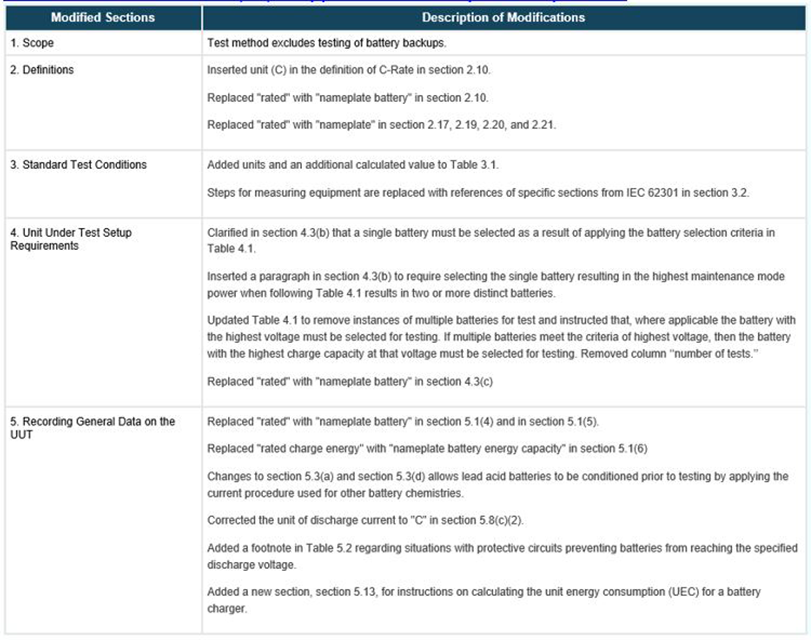Beginning November 16, 2016, battery charger system manufacturers were required to use the amended federal test method [10 C.F.R. Section 430.23(aa) - Appendix Y to Subpart B of part 430]. A mandatory efficiency standard for federally regulated battery chargers became effective for products manufactured on or after June 13, 2018. Below is a list of frequently asked questions and guidance related to the amended battery charger test procedure and federal standards, and how it interacts with California standards. On and after June 13, 2018, models of federally regulated battery chargers may be certified to the California Energy Commission (CEC) using a ‘Voluntary Status’. On and after January 1, 2019, all federally regulated battery chargers must be certified to the CEC’s database as a federally regulated consumer product. After January 2019, models that were certified with a voluntary status will be automatically changed to a ‘C’ status for a ‘Federally Regulated Consumer Product.’
If clarification is needed contact the Appliance Efficiency Program.
General
Representations made on or after November 16, 2016, regarding the energy consumption of federally regulated battery chargers must be based upon results generated under the federal test procedure for battery chargers. "Representations" include certification to the CEC.
The test procedure for federally regulated battery chargers.
The test procedure for uninterruptible power supplies.
For general questions about battery charger systems, the Appliances Efficiency Program issued a guidance letter and regulatory advisory available on visit the appliance program outreach and education bulletin page. To access additional outreach and education resources, including educational webinars, visit the outreach and education page.
Under Title 20, battery chargers are separated into two appliance types: federally regulated battery chargers, state-regulated small battery charger systems, and state-regulated large battery charger systems.
A federally regulated battery charger is a device that charges batteries for consumer products, including battery chargers embedded in other consumer products. Federally regulated battery chargers include products regulated under 10 C.F.R. Section 430.32(z). Backup battery chargers are not included in the scope of federally regulated battery chargers. There are no federal efficiency standards for uninterruptible power supplies.
A state-regulated small battery charger system – which includes uninterruptible power supplies and battery backups – is a battery charger system with a rated input power of less than 2 kilowatts (kW) and that is not covered as a federally regulated battery charger. Battery backups, uninterruptible power supplies, dry-inductive chargers, and battery chargers for non-consumer products are all covered as state-regulated battery chargers.
A state-regulated large battery charger system is a battery charger system with a rated input power of more than 2 kW and that is not covered as a federally regulated battery charger. A forklift battery charger is considered a state-regulated large battery charger system.
A battery charger is a device that charges batteries for consumer products, including battery chargers embedded in other consumer products (See 42 U.S.C. 6291(32)). Functionally, a battery charger is a power conversion device used to transform input voltage to a suitable voltage for charging the battery. Battery chargers are used in conjunction with other end-use consumer products, such as cell phones and digital cameras. However, the battery charger definition prescribed by Congress is not limited solely to products that are only powered from AC mains (or "mains") - i.e., products that plug into a wall outlet. Further, battery chargers may be wholly embedded in another consumer product, wholly separate from another consumer product, or partially inside and partially outside another consumer product.
The Energy Policy and Conservation Act (EPCA) defines a consumer product as any article of a type that consumes or is designed to consume energy and which, to any significant extent, is distributed in commerce for personal use or consumption by individuals without regard to whether such article of such type is in fact distributed in commerce for personal use or consumption by an individual. (See 42 U.S.C. 6291(1).) Manufacturers of battery chargers are advised to use this definition in conjunction with the battery charger definition to determine whether a given device is a covered product and subject to DOE’s regulations, or if it is instead regulated as a state-regulated battery charger system and subject to the CEC’s regulations.
The DOE created seven product classes for battery chargers based on various electrical characteristics shared by particular groups of products. As these electrical characteristics change, so do the utility and efficiency of the devices. Therefore, the DOE set different annual energy consumption limits for each category of battery chargers. The seven product classes are:
Testing
There are several changes to the federal regulations related to battery chargers within Title 10, Parts 429 and 430 of the Code of Federal Regulation. For more specific details on the changes in the new version of the test procedure please see the section below "Summary of Changes and Affected Sections Related to Federal Battery Chargers." In brief, the major changes are: the scope excludes backup batteries from using this test method, amended battery selection criteria for testing, a new represented value to calculate, addition of conditioning of lead acid batteries prior to being tested, and a clarified sampling methodology.
The new federal test procedure applies to most battery chargers that are consumer products being sold in California. The chart below illustrates which test procedure should be used for each type of battery charger system.
Battery Charger System Type
- Federally Regulated Battery Chargers and Uninterruptible Power Supplies
Federal Test Procedure in 10 C.F.R. 430.23(aa) (Appendix Y to Subpart B of Part 430)
- State-Regulated Battery Charger Systems
Consumer product is defined in 42 U.S.C. 6291(1). Questions regarding the applicability of the Federal Test Procedure for specific battery charger systems should be directed to the DOE at ApplianceStandardsQuestions@ee.doe.gov
- Small Battery Charger Systems and Uninterruptible power Supplies
Federal Test Procedure in 10 C.F.R. 430.23(aa) (Appendix Y to Subpart B of Part 430) that was in effect January 1, 2017
- Battery Backups
Federal Test Procedure in 10 C.F.R. 430.23(aa) (Appendix Y to Subpart B of Part 430) that was in effect January 1, 2017
The new federal test method excludes backup battery chargers from the scope of the new battery charger test procedure. However, these devices remain regulated under California’s Title 20 Appliance Efficiency Regulations and must be tested and certified using the federal battery charger test method as it appeared in the Code of Federal Regulations (CFR) on January 1, 2016, for certification in California only (10 CFR Section 430.23(aa) - Appendix Y to Subpart B of Part 430 ) (January 1, 2016).
Note: The scope of California’s state-regulated battery charger systems efficiency standard is not dependent on the operating voltage of the battery charger system, and the test procedure must be used regardless of the operating voltages of the state-regulated battery charger system that is being tested for certification to the CEC’s database.
Manufacturers may determine the number of samples tested as long as the sampling requirements are satisfied. One of these requirements is presented in the sampling plan for battery chargers per 10 CFR Section 429.39(a)(2)(i), which references 10 CFR Section 429.11, that "the minimum number of units tested shall be no less than two." Ultimately, the manufacturer should test a sample of "sufficient size" to make a statistically valid assessment and to account for variability.
Certification
Any model number certified prior to June 13, 2018, to the CEC’s Modernized Appliance Efficiency Database System (MAEDbS) will be moved from the approved database to the archived database with the exception of backup battery and uninterruptible power supply models. Model numbers of state-regulated battery charger systems that appear in the archived database may continue to be sold or offered for sale in California without recertification.
On June 13, 2018, the federal standards for consumer battery chargers went into effect and all products sold or offered for sale in California must meet the nationwide energy conservation and disclosure requirements and be certified to MAEDbS. As of January 1, 2019, all federally regulated battery charger models must be certified to the CEC as a federally regulated battery charger and appear in the approved database to be eligible to be sold or offered for sale in California.
Yes. Models of state-regulated small battery charger systems that were certified as compliant to the standard, and that were manufactured before June 13, 2018, can still be sold in California (unlimited sell-through) and will be displayed in the archived section of MAEDbS. Models manufactured on and after June 13, 2018, must be tested and certified as federally regulated battery chargers no later than January 1, 2019, if they are now covered under that appliance type.
Summary of Changes and Affected Sections Related to the Federal Battery Charger Systems
10 C.F.R. Section 430.23(aa) – Appendix Y to Subpart B of part 430
The basic model number is the model number of the battery charger. The model number is the model number of the product in which the battery charger is embedded (what the CEC refers to as a consumer product model number). If the battery charger is not embedded in a product but being certified as a stand-alone product, the model number and basic model number fields should be the same.
Yes, as long as the test procedure used was the federal test procedure that became effective on June 20, 2016.
A BC-circle mark, as described in Title 20 Section 1607(d)(10), is required on all state-regulated battery charger systems. As of October 1, 2018, the mark is not required on federally regulated battery chargers. All battery chargers must otherwise comply with the CEC’s marking requirements located in Title 20 Section 1607(b).





